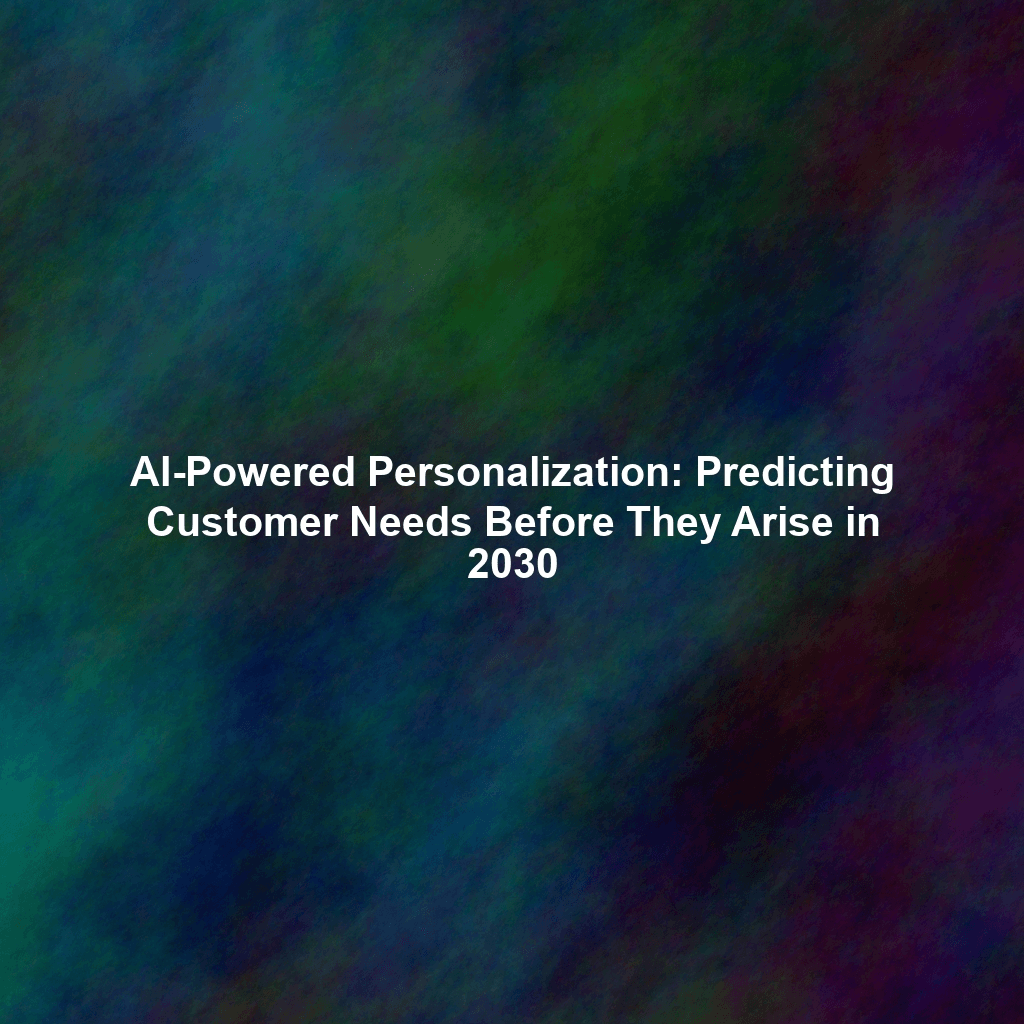Imagine a world where marketing anticipates your desires before you even realize them yourself. Welcome to 2030, where Artificial Intelligence (AI) reigns supreme in the realm of personalized customer experiences. This isn’t just about recommending products based on past purchases; it’s about understanding the nuances of your life, predicting your future needs, and delivering solutions precisely when and where you need them. But with this power comes great responsibility. This article delves into the evolution of AI in marketing, focusing on hyper-personalization, predictive analytics, and the crucial ethical considerations that will shape its use.
The Rise of Hyper-Personalization
Traditional personalization is a relic of the past. In 2030, we’re talking about hyper-personalization – a granular, real-time, and context-aware approach to marketing. AI algorithms will analyze vast datasets, including:
- Behavioral Data: Website activity, app usage, purchase history, and social media interactions.
- Contextual Data: Location, weather, time of day, and device type.
- Psychographic Data: Values, interests, lifestyle, and personality traits (gleaned ethically and responsibly).
- Biometric Data: Physiological data gathered via wearable technology (with explicit user consent and robust security).
By synthesizing this information, AI can create highly individualized experiences. Imagine receiving a targeted advertisement for a rain jacket just before a downpour is predicted in your specific location, or a personalized discount on your favorite coffee blend when you’re running low, all without you even searching for it.
From Segmentation to Individualization
The days of broad customer segments are numbered. AI allows marketers to treat each customer as an individual, tailoring every interaction to their unique needs and preferences. This leads to increased engagement, higher conversion rates, and stronger customer loyalty.
Real-Time Personalization: The Key to Engagement
Static personalization is no longer enough. Customers expect brands to respond to their needs in real-time. AI algorithms continuously monitor customer behavior and adjust marketing messages accordingly, ensuring that the right message reaches the right person at the right time.
Predictive Analytics: Foreseeing the Future
The power of AI lies not only in understanding the present but also in predicting the future. Predictive analytics uses machine learning algorithms to identify patterns in data and forecast future customer behavior. This allows marketers to:
- Anticipate Customer Needs: Identify products and services that customers are likely to need in the future, based on their past behavior and current circumstances.
- Optimize Marketing Campaigns: Predict which marketing messages will resonate with specific customers and allocate resources accordingly.
- Prevent Customer Churn: Identify customers who are at risk of leaving and proactively offer them incentives to stay.
- Personalized Pricing: Dynamically adjust prices based on predicted demand and customer willingness to pay (within ethical boundaries).
Machine Learning: The Engine of Prediction
Machine learning algorithms are constantly learning and improving, becoming more accurate in their predictions over time. This means that marketing campaigns become more effective as AI systems gather more data.
The Role of Data in Predictive Analytics
The accuracy of predictive analytics depends on the quality and quantity of data available. Marketers need to invest in data collection and management to ensure that their AI systems have the information they need to make informed predictions.
Ethical Considerations: Navigating the AI Landscape
With great power comes great responsibility. The use of AI in marketing raises a number of ethical concerns that must be addressed to ensure that it is used responsibly and ethically. These include:
- Privacy: Protecting customer data and ensuring that it is used only for legitimate purposes.
- Transparency: Being transparent about how AI is being used and giving customers control over their data.
- Bias: Avoiding bias in AI algorithms and ensuring that they are fair to all customers.
- Manipulation: Preventing AI from being used to manipulate or deceive customers.
Building Trust Through Ethical AI
Customers are more likely to trust brands that are transparent and ethical in their use of AI. Marketers need to prioritize ethical considerations and build trust with their customers by being open and honest about how they are using AI.
The Importance of Regulation
Governments and regulatory bodies need to develop clear guidelines and regulations for the use of AI in marketing to ensure that it is used responsibly and ethically. These regulations should address issues such as data privacy, transparency, and bias.
Conclusion: The Future of Marketing is Personalized and Predictive
AI-powered personalization is poised to revolutionize marketing in 2030. By leveraging the power of hyper-personalization and predictive analytics, marketers can deliver truly exceptional customer experiences that are tailored to the unique needs of each individual. However, it is crucial to address the ethical considerations surrounding the use of AI to ensure that it is used responsibly and ethically. By prioritizing privacy, transparency, and fairness, marketers can build trust with their customers and create a future where AI enhances, rather than diminishes, the customer experience. The future of marketing is personalized, predictive, and ethical.
 Skip to content
Skip to content

